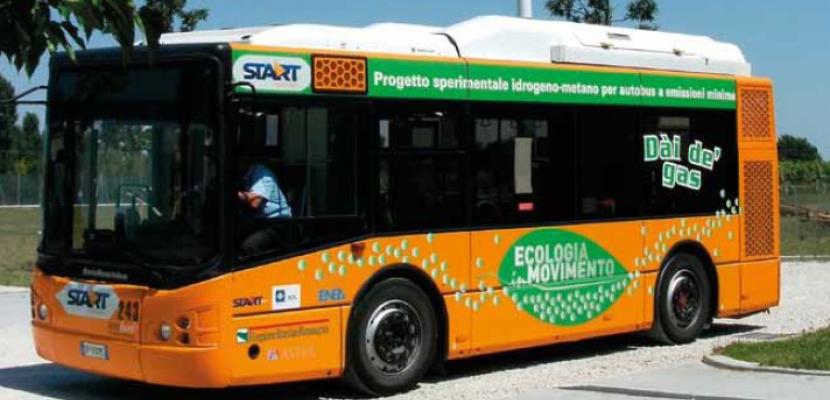
Methane and Hydrogen blend for public city transport bus

About this good practice
Transport is responsible for the 32% of total CO2 emissions in Emilia-Romagna region.
Research by ENEA research centre in 2006 showed that low percentages of hydrogen in methane reduce CO2 emissions and fuel consumption, because the water vapour produced through hydrogen combustion is energetically favourable. As In Emilia-Romagna 12% of the regional public transport fleet was methane fuelled, and the region is well served by the methane grid, hydro-methane had a significant potential to be deployed as alternative fuel. The project tested the environmental and technical aspects of using a blend of hydrogen and methane for an urban city transport bus. After bench tests and verifications about the safety of hydrogen and methane blend (15% H2 and 85% CH4), the hydromethane fuelled prototype was realized.
A dedicated hydromethane fuelling station was designed and built at the premises of a local hydrogen production facility. During the 45.000 km of road tests, performed according to a protocol defined with the Ministry of transport, CO2 emissions and fuel consumption were monitored by ENEA.
Beneficiaries were Emilia-Romagna Region, ENEA, Ravenna Municipality through the controlled bus company.
The key stakeholder groups for the project were: regional public transport companies; regional citizens; regional and local policy makers; local sustainable mobility agencies; vehicles and components manufacturers; public transport associations, natural gas producing associations.
Expert opinion
The MHyBus project aligns with EU policy goals of reducing greenhouse gas emissions in public transport and promoting cleaner alternative fuels and demonstrates how a hydrogen-methane blend can be a transitional fuel that supports decarbonisation by building on existing methane infrastructure. It highlights the potential of hybrid fuels, but also underscores the importance of regulatory flexibility and funding support to scale up green technologies in transport.
Resources needed
Total budget € 1.322.794
EU contribution: € 589.079
Evidence of success
MHyBus results in figures:
1 hydro-methane prototype bus
1 dedicated hydro-methane fuelling station within a local hydrogen production plant
1 protocol of road tests for circulation on urban roads agreed with Ministry of Transport
45.898 km run on public roads in Ravenna (220 km a day)
> 10.000 transported passengers
5,98 tons of CO2 emissions saved
12,6 tons of produced hydro-methane
1,8 tons of saved methane
The project was acknowledged as part of LIFE Environment Best Awards in 2014.
Potential for learning or transfer
The project can be considered as pioneer both for technical application and for defining the procedures to be applied for the homologation of a public transport vehicle.
MHyBus demonstrated that upgrade to hydro-methane does not require large investments as, at low hydrogen percentages, safety issues of the blend are similar to those of methane.
The experiment proved to be successful in Ravenna, where a high efficient hydrogen production plant is present, which could be used for the blend.
But there was no follow up in the public transport sector due to:
- lack of public funding for increasing fuel station capacity
- legal bindings on the percentage of hydrogen allowed in the public transport blended fuels.
Nonetheless hydro-methane was used in existing natural gas pipelines by gas distribution companies (SNAM) and also in some ceramics production facilities.
After passing into oblivion for some time hydrogen blending is now deemed a viable solution for the hard-to-abate sector.

